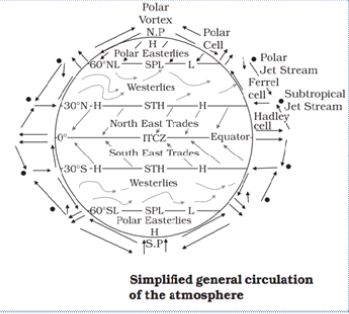


Instruction:
- There will be 2 questions carrying 10 marks each. Write your answers in 150 words
- Any page left blank in the answer-book must be crossed out clearly.
- Evaluated Copy will be re-uploaded on the same thread after 2 days of uploading the copy.
- Discussion of the question and one to one answer improvement session of evaluated copies will be conducted through Google Meet with concerned faculty. You will be informed via mail or SMS for the discussion.
Question #1. What is air mass? Discuss conditions for growth of an airmass. How air masses are responsible for modification of weather conditions?
Question #2. Explain is Tri-meridional circulation. Give climatic significances of meridional circulations.
(Examiner will pay special attention to the candidate's grasp of his/her material, its relevance to the subject chosen, and to his/ her ability to think constructively and to present his/her ideas concisely, logically and effectively).
STEPS & INSTRUCTIONS for uploading the answers
Step 1 - The Question for the day is provided below these instructions. It will be available at 7:00 AM.
Step 2 - Uploading of Answers : Write the answer in A4 Sheet leaving proper margins for comments and feedback and upload the PDF in MY ACCOUNT section. Click on the option of SUBMIT COPY to upload the PDF.
Step 3 - Deadline for Uploading Answers: The students shall upload their answers by 7:00 PM in the evening same day. The first 50 copies will be evaluated.
Step 4 - Feedback : Mentors will give their feedback for the answers uploaded. For more personalised feedback, join our telegram channel by clicking on the link https://t.me/mains_answer_writing_cse . A one-to-one session will be conducted with the faculty after copy evaluation in 72 Hrs.
Model Answer
Question #1. What is air mass? Discuss conditions for growth of an airmass. How air masses are responsible for modification of weather conditions?
Air mass is an immense body of air with relative homogenous physical properties in terms of temperature, humidity and density. It develops in horizontal layers produced by thermodynamics modification in the planetary winds. Air mass is part of secondary circulation of wind. They are identified by their contrast physical properties in relation to the surrounding air.
Growth of an airmass:
- Homogenous surface in terms of topography and relief, mostly flat surface ideal for origin of an airmass.
- Isotropic surface which means it can be either land or the sea because the sea surface and land surface have differential rate of heating and contrasting physical properties. Thus, at coast an airmass does not develop due to temperature contrast.
- The kinetic energy of the wind equal to the frictional force. Thus, wind velocity over the ground is near zero. That make condition ideal for origin of an airmass.
- The process of thermal exchange or heating from surface must not be by convective mechanism because convection can generate turbulence in the air. A better or more suitable mechanism is conduction or molecular exchange of heat.
- Conduction through various layers may result in development of horizontal strata and greater homogeneity has been found in the horizontal column of air which is highly favourable for origin of an airmass.
- Airmass move with the planetary wind system and their track is determined by wind velocity and the effect of Coriolis.
- Intense insolation heating, rugged surface, cyclonic circulation and other severe atmospheric disturbances are unfavourable conditions for development of an airmass.
Airmasses have been classified on the basis of their source region and they have been modified due to thermal condition and dynamic effects.
When an airmasses approaches to destination, there it has been identified by its physical properties on the basis of either temperature of surface or contrast airmass. Consequently, modification in airmass and weather starts occurring.
Modification of weather conditions
Winter time Polar – Continental airmass develops over Greenland, Northern Canada, Siberia and Antarctica. During winters these regions are extremely cold. Therefore, cold airmass develops over these cold surfaces and airmass has been identified as CPKs airmass i.e. continental-polar-cold-stable airmass.
After developing a mature airmass, it comes under effect of polar easterlies and it has been dragged towards warm oceanic surface. Due to heating from below, convection process starts. It results in formation of cumulo-nimbus clouds with thundering and lightening and heavy rainfall occurs but intensity of rainfall depends upon relative humidity in the airmass.
Thus, mixing of CPK becomes unstable and weather disturbances occur.
Similarly, Continental-Tropical-Warm-Stable airmass develops over continental masses in tropical areas. Over a homogenous surface it is a stable airmass as long as it stays over continental airmass. Thus, this airmass has been expressed as CTWs airmass.
CTWs airmass comes under effect of tropical easterly winds and they have been dragged to equatorial zone. It comes in effects strong convection in equatorial zone and it becomes unstable. Here, this airmass has been expressed as CTWu.
In process of convection, it becomes part of vertical ascending air current which produces dense, vertical clouds known as cumulo-nimbus clouds. It precipitates very heavily which is known as torrential rain. Such rain creates extreme weather disturbances with strong thundering, lightening and convectional rain during noon time which is known as 2 pm to 4 pm rain.
It can be concluded as, an airmass confined to stable airmass in initial stage of formation but it certainly creates extreme weather disturbances over different latitudinal zones over the globe.
Question #2. Explain is Tri-meridional circulation. Give climatic significances of meridional circulations.
Tri-meridional circulation is movement of wind vertically and horizontally in between pressure belts. The concept of tri-meridional circulation was put forward by Palmen in 1951.
Tri-meridional circulation as atmospheric circulation form cells of wind flow. These cells are:
- Hadley Cell (tropical cell)
- Ferrel cell (Polar front cell)
- Polar cell
Hadley Cell: this atmospheric circulation take place in tropical region therefore, also called tropical cell. It was discovered by Hadley in 1735, thus, also known as Hadley cell.
- In equatorial zone, due to vertical sun’s rays, air becomes warm and light, leads to development of low pressure centre in between 10 degree north and south i.e. known as Doldrum Belt/zone.
- Warm air ascends as air current and release latent heat which leads to establishment of convection process and formation of cumulo-nimbus clouds. This clouds precipitates heavily in form of torrential rain i.e. is known as conventional rain. As this rainfall occurs during 2 pm to 4 pm, so this is called 2 to 4 pm rain or afternoon rain.
- Such rainfall phenomena take place everyday with greater amount. Thus, average annual rainfall in equatorial zone occurs 250 cm and more which is sufficient to grow equatorial rain forests.
Figure 1: Tri-meridional Circulation - The ascending current reaching at limit of tropopause, it diverts and proceeds towards poles but it descends on 30 degree to 35 degree latitudes in both hemispheres where it creates dynamic high pressure zone which also becomes source of tropical easterly and part of Hadley Cell circulation (fig. 1).
- Hadley cell has been more pronounced in southern hemisphere than northern hemisphere because drastic change in thermal zones over Indian sub-continent which changes position of low pressure zone and pattern of wind blow.
Ferrel Cell: it is responsible for formation of front in sub-polar region, therefore also called polar front cell. Winds blowing from sub-tropical high pressure zone to sub-polar zone are part of this system i.e. known as westerlies (fig. 1).
- Due to Coriolis force, wind direction becomes southwest to northeast, therefore they are called westerlies.
- Westerlies moving eastward influence temperate cyclone over western margins of continents in temperate zone.
- Westerly winds confluence with polar easterlies and create fronts which becomes initial stage of formation of temperate cyclone.
- Confluence of polar easterly i.e. cold and warm westerly make warm air to rise where convection process leads to formation of cumulo-nimbus clouds and heavy precipitation occurs with thundering and lightening. But this precipitation is not similar to torrential rain in equatorial zone.
- Ferrel cell circulation maintains heat balance in mid-latitude zones.
Polar Cell: this cell develops between 60 degree to 90 degree latitudes in both hemispheres. It is anticyclonic conditions over sub-polar and polar region due to subsidence of air from atmosphere.
- From high pressure zone in polar areas, winds blow towards sub-polar zone. Direction of wind become northeast to southwest under effect of Coriolis i.e. wind is called polar easterlies.
- In sub-polar zone, polar easterlies converge with warm westerlies, this contrasting nature is known as “Polar Front”.
- This flow of mass winds is responsible for creating disturbances in weather.
Climatic Significances
- Transfer of heat from lower to upper atmosphere.
- Convergence of trade winds in Inter Tropical Convergence Zone and in Sub-tropical High Pressure Zone make a substantial contribution in the transfer of energy.
- This circulation significantly contribute in development of temperate and tropical cyclone.
- Vertical disturbances are also result of transfer of heat in Hadley cells.
- Formation of hot deserts, horse latitudes and roaring forties are part of tri-meridional circulation
- Seasons, climate, climatic zones, vegetation zones, and several biotic system in different regions of world are directly and indirectly affected by tri-meridional circulation.
It can be concluded in last that tri-meridional circulation is continuous prevailing air flow which affects atmosphere in different facets at short term in form of weather and long term in developing seasons and climate.



